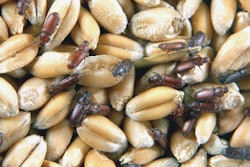
Like many things in this industry, mycotoxins seem like an unavoidable force of nature. Much like a drought or flood, their presence is out of an individual facility’s control. So, when harvest is here, and trucks are lined up down the road, it is easy to forget about proper procedure, do a quick probe and send the truck on its way. What harm could come of it? — A lot. Not properly testing for mycotoxins can lead to infected grain entering the bin, creating hot spots and ultimately making the problem far worse. If high mycotoxin levels cause a shipment to be rejected, or even worse, affect the health of animals or humans, the damages could add up to millions of dollars.
“One grain dealer, in a case I was on, wasn’t doing adequate testing, causing the customer to lose a bunch of poultry,” notes John L. Richard, consultant for Romer Labs. “They had no records of most of their testing, but a video proved they weren’t doing enough. They ended up going under.”
With a company’s future one mishap from nonexistence, the question becomes not “should I have a good mycotoxin management plan,” but “how do I get started setting one up?”
The economics of a plan vs. doing nothing
The costs to set up a mycotoxin management plan come down to two things: the cost of the testing supplies themselves, and the higher cost in man-hours. As Richard stated earlier, the monetary cost can easily put a smaller facility under and cause significant harm to any but the largest of companies. The damage an incident can have to consumers’ image of the company and trust in its brand will have untold cost for years to come. The potential for harm has gotten the attention of the industry, and the current standard is to test more precisely and over a wider range.
“When I first started with my company, typically grain handlers tested for aflatoxins, maybe for fumonisins,” says Patricia Jackson, market development manager at Vicam. “Within the last five years, we’re hearing of grain handlers doing surveys for all major mycotoxins that can affect producers. The more knowledge that comes out of the research field, the more the grain industry is interested in all of the mycotoxins that might impact their business.”
Written plan
In some areas of the country, it may be five to 10 years in between issues with mycotoxins. With such large gaps in time, there’s no guarantee that the same management will be in place or that they will know what actions to take in an ever-changing regulatory market. The best course of action is to have a written plan in place and to train employees on it. Make sure they know not only about proper sampling, testing and analysis, but also the procedures in place for when an emergency situation happens.
Changing the culture
The biggest challenge any mycotoxin management plan will face is the lack of commitment to maintaining the predetermined practices that are put in place. Those practices are vital because they allow facilities to take action before a problem arises. It may require a change in the company culture and an effort to instill the value of testing in all employees.
“The first step is to develop a culture of safety,” explains Richard. “Everyone must be on board that adequate testing is a must, from management all the way down to the guy collecting that sample. I’ve seen companies that go under just because they don’t have that culture.”
Where to begin
Issues can arise at any time, so mycotoxin management plans and continuity plans should be worked into the portfolios of grain handling companies. The size and cost of the plan will depend on an individual facility’s needs.
“A mycotoxin management plan will vary throughout the industry,” says Jackson. “ It will depend on where the grain handler is located, local geography and other risk factors, but it should always have some major components. Including a sampling plan, mapping out risk factors, and if it’s determined that any areas are at risk, test them beforehand.”
Luckily, there are resources available from federal and state governments, universities and the private sector, many of which are little to no cost.
“We offer an integrated program that begins with an extensive discussion with grain quality personnel and operations management,” says Pat Frasco, director of sales – milling and grain at Neogen Corporation. “We want to understand their business, the commodities they deal with, user market they’re selling to, any value-added processing they do and how logistically the grain is handled. Those are some of the things we look at when figuring out what kind of testing they should do, whether it be qualitative screening tests or quantitative testing. “
Pre-harvest considerations
During the summer months before a single truck arrives to be scaled and tested, a good mycotoxin management plan should be in full swing. Just as managers will look at crop reports to estimate the size of the harvest, mycotoxin reports from both private companies and university extensions are available to help track what type of mycotoxins may be showing up in local fields.
Weather plays a large role in the type and abundance of the mycotoxins in an area. Hot, dry weather is better for aflatoxins, so if the area around the facility has been dry, increased testing for aflatoxins might be the wisest expenditure of both time and money.
“If you have hail or insects in the area, it can cause damage to the crop, leading to an increased risk of fungal infection, which can lead to increased mycotoxin production,” explains Erin Bowers, post-doctoral research associate in agricultural and biosystems engineering at Iowa State University.
findi秋收之前的那次的最后一块拼图ng the time to get out to suppliers’ fields and take a firsthand look at the crop that will be coming in at harvest-time. Search for any issues yourself and talk to the farmers that spend night and day among the crop. For a large client, the facility may ask them to do their own screening before delivery, in order to know how vigorously to test. These steps will help guide the level of testing a facility should do in the fall once grain starts to arrive.
“Scouting!” suggests Bowers. “If you know your suppliers and have the man power, get out into the field. Look to identify any problems in that crop year.”
Sample, test and repeat
After pre-harvest information gathering, each facility has to set up a plan for testing depending on the risk factors from the surrounding area. Taking everything from weather patterns to region into account, the facility will then determine how much testing needs to be performed on the initial trucks coming in. The amount of testing will also be determined by whom the facility’s desired customers are, with commodities going into pet food and animal feed having stricter standards.
Proper sampling is the most effective way to manage mycotoxins. Dealing with high concentrations before they’re accepted into the facility will save much larger headaches down the road.
“Some grain handlers take a cup full of grain, blend it with solvent, then take a reading,” Richard explains. “You can’t do that. Grind the sample first and then mix it. You may have only one kernel that’s contaminated, but when its ground to 10,000 parts and you mix it with all the other broken kernels, it will be a much more accurate reading.”
The United States Department of Agriculture Grain Inspection, Packers & Stockyards Administration has more information on proper testing amounts for various containers at www.gipsa.usda.gov. The standard is to take samples from various sections for the first few loads from a location, grind them together and take the reading or perform a disposable test. If there are no issues after the first few weeks of harvest, testing can be cut back.
Post-harvest storage and management
Not all industries will turn away the same levels of contaminated grain. Knowing what levels are acceptable in different industries can save a seemingly unusable load.
“Be more proactive rather than reactive,” Bowers advises. “Know what’s going into the facility and what’s coming out of the facility. Know who your suppliers are and who your end users are. Someone supplying to feedlot cattle will have a lot more flexibility than someone going to swine.”
One of the keys to stopping any mycotoxin is proper storage of the grain itself. By practicing proper temperature monitoring and aeration, a facility can keep a small problem from getting worse.
“Mycotoxin management isn’t just about asking what will this crop year look like,” says Frasco. “In many cases, with more typical carryover levels, you’re going to be managing the crop that’s coming out of last year’s storage. In some cases, it may go back two years, and this can aggravate mycotoxin levels in storage, especially if they’ve been stored on a farm or in less than optimal conditions. These are the part of the risk profile that we try to help companies identify and manage appropriately.”
Even if a load has to be distilled for ethanol and the remains destroyed, rarely is it worthless. With the proper plan, a contaminated load should be detected before entering storage.

.jpg?auto=format%2Ccompress&crop=faces&fit=crop&h=48&q=70&w=48)




















![Optimix Andritz Scaled[1]](https://img.feedandgrain.com/files/base/wattglobalmedia/all/image/2023/05/optimix_Andritz_scaled_1_.645eb7a1ed508.png?auto=format%2Ccompress&fit=crop&h=112&q=70&w=112)